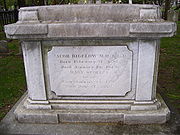
Jacob Bigelow
Encyclopedia

Mount Auburn Cemetery
Mount Auburn Cemetery was founded in 1831 as "America's first garden cemetery", or the first "rural cemetery", with classical monuments set in a rolling landscaped terrain...
in Cambridge, Massachusetts
Cambridge, Massachusetts
Cambridge is a city in Middlesex County, Massachusetts, United States, in the Greater Boston area. It was named in honor of the University of Cambridge in England, an important center of the Puritan theology embraced by the town's founders. Cambridge is home to two of the world's most prominent...
.
Biography
Bigelow was born in Sudbury, MassachusettsSudbury, Massachusetts
Sudbury is a town in Middlesex County, Massachusetts, United States, population 17,659. The town was incorporated in 1639, with the original boundaries including what is now Wayland. Wayland split from Sudbury in 1780. When first incorporated, it included and parts of Framingham, Marlborough, Stow...
on February 7, 1787 (other sources claim 1786). Bigelow graduated from Harvard College
Harvard College
Harvard College, in Cambridge, Massachusetts, is one of two schools within Harvard University granting undergraduate degrees...
in 1806 and then studied under John Gorham
Gorham
Gorham or Goreham is a surname, and may refer to:*Arthur F. Gorham , American soldier*Benjamin Gorham , American politician*Christopher Gorham , American actor...
. He then graduated from the University of Pennsylvania
University of Pennsylvania
The University of Pennsylvania is a private, Ivy League university located in Philadelphia, Pennsylvania, United States. Penn is the fourth-oldest institution of higher education in the United States,Penn is the fourth-oldest using the founding dates claimed by each institution...
medical school in 1810. He also studied under botantist Benjamin Barton. He was elected a Fellow of the American Academy of Arts and Sciences
American Academy of Arts and Sciences
The American Academy of Arts and Sciences is an independent policy research center that conducts multidisciplinary studies of complex and emerging problems. The Academy’s elected members are leaders in the academic disciplines, the arts, business, and public affairs.James Bowdoin, John Adams, and...
in 1812.
Bigelow taught medicine and botany at Harvard and published numerous books, including one of America's first botanical books, American Medical Botany. His interest in mechanics led to his appointment as Rumford Professor, a position endowed at Harvard for the purpose of teaching the application of science to the useful arts, which he held from 1816 to 1827. His interest in mechanics and non-biological sciences was also illustrated by the publication of his Elements of Technology in 1829.
Bigelow came up with the idea for Mount Auburn Cemetery as early as 1825, though a site was not acquired until five years later. Bigelow was concerned about the unhealthiness of burials under churches as well as the possibility of running out of space. With help from the Massachusetts Horticultural Society
Massachusetts Horticultural Society
The Massachusetts Horticultural Society, sometimes abbreviated to MassHort, is an American horticultural society based in Massachusetts. It describes itself as the oldest, formally-organized horticultural institution in the United States...
, Mount Auburn Cemetery was founded on 70 acres (283,280.2 m²) of land authorized by the Massachusetts Legislature for use as a garden or rural cemetery. It was dedicated in 1831 by Joseph Story
Joseph Story
Joseph Story was an American lawyer and jurist who served on the Supreme Court of the United States from 1811 to 1845. He is most remembered today for his opinions in Martin v. Hunter's Lessee and The Amistad, along with his magisterial Commentaries on the Constitution of the United States, first...
, first president of the Mount Auburn Association.
Bigelow died on January 10, 1879 and was buried in Mount Auburn Cemetery.
Critique of Benjamin Rush and Heroic Medicine
Bigelow came to prominence also by challenging the effectiveness of the therapeutics of the day. He published a book, Discourse on Self-Limited Diseases, in which he attacked physicians' blind allegiance to drugs and medical intervention that were embodied in heroic practice. To establish support, Bigelow wrote on how the outcomes among treated and untreated patients alike were similar, regarding the use of heroic therapies. Interventions had little effect. Bigelow’s deprications helped form a new conceptual nucleus around which medical orthodoxy could begin to redefine itself. (Paul Starr: Transformations in American Medicine)Selected publications
- An introduction to physiological & systematical botany (1814)
- Florula bostoniensi (1814, 1st Edition)
- American medical botany (1817–20) (Vol. 1–3)
- Florula bostoniensi (1824, 2nd Edition)

